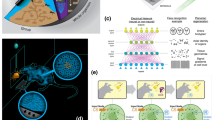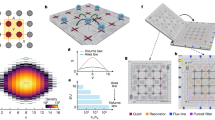Abstract
The ambition of harnessing the quantum for computation is at odds with the fundamental phenomenon of decoherence. The purpose of quantum error correction (QEC) is to counteract the natural tendency of a complex system to decohere. This cooperative process, which requires participation of multiple quantum and classical components, creates a special type of dissipation that removes the entropy caused by the errors faster than the rate at which these errors corrupt the stored quantum information. Previous experimental attempts to engineer such a process1,2,3,4,5,6,7 faced the generation of an excessive number of errors that overwhelmed the error-correcting capability of the process itself. Whether it is practically possible to utilize QEC for extending quantum coherence thus remains an open question. Here we answer it by demonstrating a fully stabilized and error-corrected logical qubit whose quantum coherence is substantially longer than that of all the imperfect quantum components involved in the QEC process, beating the best of them with a coherence gain of G = 2.27 ± 0.07. We achieve this performance by combining innovations in several domains including the fabrication of superconducting quantum circuits and model-free reinforcement learning.
This is a preview of subscription content, access via your institution
Access options
Access Nature and 54 other Nature Portfolio journals
Get Nature+, our best-value online-access subscription
$29.99 / 30 days
cancel any time
Subscribe to this journal
Receive 51 print issues and online access
$199.00 per year
only $3.90 per issue
Buy this article
- Purchase on Springer Link
- Instant access to full article PDF
Prices may be subject to local taxes which are calculated during checkout




Similar content being viewed by others
Data availability
The data that support the findings of this study are available from the corresponding authors upon a request.
Code availability
The open-source implementation of the proximal policy optimization algorithm is available in ref. 29. The custom code used for quantum control optimization, data acquisition, analysis and visualization is available from the corresponding authors upon a request.
References
Hu, L. et al. Quantum error correction and universal gate set operation on a binomial bosonic logical qubit. Nat. Phys. 15, 503–508 (2019).
Gertler, J. M. et al. Protecting a bosonic qubit with autonomous quantum error correction. Nature 590, 243–248 (2021).
Campagne-Ibarcq, P. et al. Quantum error correction of a qubit encoded in grid states of an oscillator. Nature 584, 368–372 (2020).
Krinner, S. et al. Realizing repeated quantum error correction in a distance-three surface code. Nature 605, 669–674 (2022).
Zhao, Y. et al. Realization of an error-correcting surface code with superconducting qubits. Phys. Rev. Lett. 129, 030501 (2022).
Sundaresan, N. et al. Matching and maximum likelihood decoding of a multi-round subsystem quantum error correction experiment. Preprint at https://arxiv.org/abs/2203.07205 (2022).
Google Quantum AI. Suppressing quantum errors by scaling a surface code logical qubit. Nature 614, 676–681 (2023).
Knill, E. & Laflamme, R. Theory of quantum error-correcting codes. Phys. Rev. A 55, 900–911 (1997).
Gottesman, D., Kitaev, A. & Preskill, J. Encoding a qubit in an oscillator. Phys. Rev. A 64, 012310 (2001).
Mirrahimi, M. et al. Dynamically protected cat-qubits: a new paradigm for universal quantum computation. N. J. Phys. 16, 045014 (2014).
Michael, M. H. et al. New class of quantum error-correcting codes for a bosonic mode. Phys. Rev. X 6, 031006 (2016).
Shor, P. W. Scheme for reducing decoherence in quantum computer memory. Phys. Rev. A 52, R2493–R2496 (1995).
Steane, A. M. Error correcting codes in quantum theory. Phys. Rev. Lett. 77, 793–797 (1996).
Fowler, A. G., Mariantoni, M., Martinis, J. M. & Cleland, A. N. Surface codes: towards practical large-scale quantum computation. Phys. Rev. A 86, 032324 (2012).
Noh, K. & Chamberland, C. Fault-tolerant bosonic quantum error correction with the surface–Gottesman-Kitaev-Preskill code. Phys. Rev. A 101, 012316 (2020).
Terhal, B. M., Conrad, J. & Vuillot, C. Towards scalable bosonic quantum error correction. Quantum Sci. Technol. 5, 043001 (2020).
Ofek, N. et al. Extending the lifetime of a quantum bit with error correction in superconducting circuits. Nature 536, 441–445 (2016).
de Neeve, B., Nguyen, T.-L., Behrle, T. & Home, J. P. Error correction of a logical grid state qubit by dissipative pumping. Nat. Phys. 18, 296–300 (2022).
Ryan-Anderson, C. et al. Realization of real-time fault-tolerant quantum error correction. Phys. Rev. X 11, 041058 (2021).
Egan, L. et al. Fault-tolerant control of an error-corrected qubit. Nature 598, 281–286 (2021).
Waldherr, G. et al. Quantum error correction in a solid-state hybrid spin register. Nature 506, 204–207 (2014).
Abobeih, M. et al. Fault-tolerant operation of a logical qubit in a diamond quantum processor. Nature 606, 884–889 (2022).
Xue, X. et al. Quantum logic with spin qubits crossing the surface code threshold. Nature 601, 343–347 (2022).
Place, A. P. et al. New material platform for superconducting transmon qubits with coherence times exceeding 0.3 milliseconds. Nat. Commun. 12, 1779 (2021).
Reagor, M. et al. Quantum memory with millisecond coherence in circuit QED. Phys. Rev. B 94, 014506 (2016).
Royer, B., Singh, S. & Girvin, S. M. Stabilization of finite-energy Gottesman-Kitaev-Preskill states. Phys. Rev. Lett. 125, 260509 (2020).
Sutton, R. S. & Barto, A. G. Reinforcement Learning: an Introduction (MIT Press, 2018).
Schulman, J., Wolski, F., Dhariwal, P., Radford, A. & Klimov, O. Proximal policy optimization algorithms. Preprint at https://arxiv.org/abs/1707.06347 (2017).
Guadarrama, S. et al. TF-Agents: a library for reinforcement learning in TensorFlow. GitHub https://github.com/tensorflow/agents (2018).
Lescanne, R. et al. Exponential suppression of bit-flips in a qubit encoded in an oscillator. Nat. Phys. 16, 509–513 (2020).
Lloyd, S. & Viola, L. Engineering quantum dynamics. Phys. Rev. A 65, 010101 (2001).
Shen, C. et al. Quantum channel construction with circuit quantum electrodynamics. Phys. Rev. B 95, 134501 (2017).
Chen, Z. et al. Measuring and suppressing quantum state leakage in a superconducting qubit. Phys. Rev. Lett. 116, 020501 (2016).
Eickbusch, A. et al. Fast universal control of an oscillator with weak dispersive coupling to a qubit. Nat. Phys. 18, 1464–1469 (2022).
Kelly, J. et al. Optimal quantum control using randomized benchmarking. Phys. Rev. Lett. 112, 240504 (2014).
Werninghaus, M. et al. Leakage reduction in fast superconducting qubit gates via optimal control. npj Quantum Inf. 7, 14 (2021).
Sivak, V. V. et al. Model-free quantum control with reinforcement learning. Phys. Rev. X 12, 011059 (2022).
Terhal, B. M. & Weigand, D. Encoding a qubit into a cavity mode in circuit QED using phase estimation. Phys.l Rev. A 93, 012315 (2016).
Hastrup, J. & Andersen, U. L. Improved readout of qubit-coupled Gottesman-Kitaev-Preskill states. Quantum Sci. Technol. 6, 035016 (2021).
Klimov, P. V. et al. Fluctuations of energy-relaxation times in superconducting qubits. Phys. Rev. Lett. 121, 90502 (2018).
Nielsen, M. A. A simple formula for the average gate fidelity of a quantum dynamical operation. Phys. Lett. A 303, 249–252 (2002).
Bravyi, S. & Kitaev, A. Universal quantum computation with ideal Clifford gates and noisy ancillas. Phys. Rev. A 71, 022316 (2005).
Grimm, A. et al. Stabilization and operation of a Kerr-cat qubit. Nature 584, 205–209 (2020).
Chen, Z. et al. Exponential suppression of bit or phase errors with cyclic error correction. Nature 595, 383–387 (2021).
Andersen, C. K. et al. Repeated quantum error detection in a surface code. Nat. Phys. 16, 875–880 (2020).
Ma, W.-L. et al. Path-independent quantum gates with noisy ancilla. Phys. Rev. Lett. 125, 110503 (2020).
Rosenblum, S. et al. Fault-tolerant detection of a quantum error. Science 361, 266–270 (2018).
Puri, S. et al. Stabilized cat in a driven nonlinear cavity: a fault-tolerant error syndrome detector. Phys. Rev. X 9, 041009 (2019).
Ni, Z. et al. Beating the break-even point with a discrete variable-encoded logical qubit. Nature https://doi.org/10.1038/s41586-023-05784-4 (2023).
Gross, J. A., Caves, C. M., Milburn, G. J. & Combes, J. Qubit models of weak continuous measurements: Markovian conditional and open-system dynamics. Quantum Sci. Technol. 3, 024005 (2018).
Pfaff, W. et al. Controlled release of multiphoton quantum states from a microwave cavity memory. Nat. Phys. 13, 882–887 (2017).
Acknowledgements
We acknowledge discussions with R. Cortiñas, J. Claes and A. Mi. We thank B. Huard for feedback on the manuscript. This research was supported by the US Army Research Office under grants W911NF-18-1-0212 and W911NF-16-1-0349, and by the US Department of Energy, Office of Science, National Quantum Information Science Research Centers, Co-design Center for Quantum Advantage (C2QA) under contract number DE-SC0012704. The views and conclusions contained in this document are those of the authors and should not be interpreted as representing official policies, either expressed or implied, of the US Government. The US Government is authorized to reproduce and distribute reprints for Government purposes notwithstanding any copyright notation herein. The use of fabrication facilities was supported by the Yale Institute for Nanoscience and Quantum Engineering and the Yale SEAS Cleanroom.
Author information
Authors and Affiliations
Contributions
V.V.S., A.M. and A.E. built the experimental setup. R.J.S. contributed to experimental apparatus. I.T., S.G. and L.F. fabricated the transmon chip. B.R., S.S. and S.M.G. developed the theory. B.R., V.V.S., A.E. and B.L.B. developed dissipative oscillator cooling. A.E., V.V.S. and A.Z.D. developed the state initialization technique. V.V.S. implemented RL, carried out the experiments and analysed data. V.V.S., A.E., B.R. and M.H.D. regularly discussed the project and provided insight. M.H.D. supervised the project. V.V.S. and M.H.D. wrote the manuscript with feedback from all authors.
Corresponding authors
Ethics declarations
Competing interests
R.J.S., L.F. and M.H.D. are founders, and R.J.S. and L.F. are shareholders of Quantum Circuits, Inc.
Peer review
Peer review information
Nature thanks Atsushi Noguchi and the other, anonymous, reviewer(s) for their contribution to the peer review of this work. Peer reviewer reports are available.
Additional information
Publisher’s note Springer Nature remains neutral with regard to jurisdictional claims in published maps and institutional affiliations.
Supplementary information
Supplementary Information
This file contains the following four sections and additional references: I. Experimental setup and sample parameters; II. Calibration and characterization experiments; III. Quantum control optimization; and IV. QEC of the grid code.
Rights and permissions
Springer Nature or its licensor (e.g. a society or other partner) holds exclusive rights to this article under a publishing agreement with the author(s) or other rightsholder(s); author self-archiving of the accepted manuscript version of this article is solely governed by the terms of such publishing agreement and applicable law.
About this article
Cite this article
Sivak, V.V., Eickbusch, A., Royer, B. et al. Real-time quantum error correction beyond break-even. Nature 616, 50–55 (2023). https://doi.org/10.1038/s41586-023-05782-6
Received:
Accepted:
Published:
Issue Date:
DOI: https://doi.org/10.1038/s41586-023-05782-6
This article is cited by
-
An elementary review on basic principles and developments of qubits for quantum computing
Nano Convergence (2024)
-
Surpassing millisecond coherence in on chip superconducting quantum memories by optimizing materials and circuit design
Nature Communications (2024)
-
Universal control of a bosonic mode via drive-activated native cubic interactions
Nature Communications (2024)
-
Encoding a magic state with beyond break-even fidelity
Nature (2024)
-
Heralded entanglement between error-protected logical qubits for fault-tolerant distributed quantum computing
Science China Physics, Mechanics & Astronomy (2024)
Comments
By submitting a comment you agree to abide by our Terms and Community Guidelines. If you find something abusive or that does not comply with our terms or guidelines please flag it as inappropriate.



